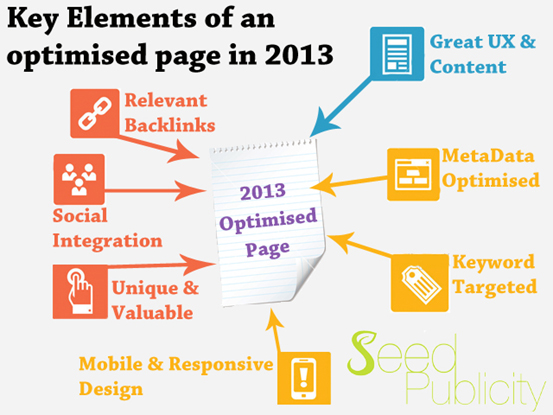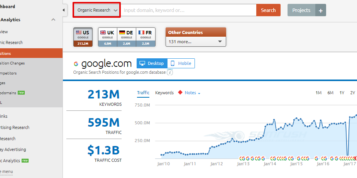The world of SEO is constantly evolving, and with murmurings leading search engines like Google updating and refining its algorithm up to 500 times per year, webmasters, editors and SEO consultants need to keep up to date and ahead of the game.
What were once strong ranking factors often get downgraded to have minimal or no effect, and in some cases become detrimental to your search engine ranking factors. So it’s up to us, the humans, to follow ‘best SEO practice’, play along to the rules to deliver the best possible information to search engines in order to rank well for search queries, keywords and phrases.
There are hundreds of guides, blogs and articles on the best practice guidelines for SEO out there, but very seldom do they actually, and quite simply, tell us how to optimise a webpage.
The graphic below demonstrates the best possible onpage ranking factors for 2013:

Great UX & Onpage Content
Whilst having fantastic onpage content, and great user experience isn’t anything revolutionary to the world of SEO, in 2013 it’s more important than ever before.
User experience should always come first. Websites shouldn’t be built for search engines, and the webmaster’s onpage content has to reflect this concept.
The page design needs to be aesthetically pleasing; with a clear navigation that puts the user first. Content needs to be useful and relevant to what that page represents. It’s no good having a page full of contradicting content, with page titles, keywords, meta data and loads of anchor text links thrown in there for the sake of ranking – it simply won’t work.
Optimised Meta Data
Another aspect of SEO that hasn’t changed, and probably never will is optimising onpage Meta data. We’ve been here many times, and it’s almost always the first stop for webmasters and SEO consultants but it’s no truer than before – optimised Meta data matters!
However, search engines have become savvier as time has gone by so instead of stuffing your page titles with as many keywords as you can, consider what the most relevant keywords are for each unique page.
Make sure the Meta Data for every single page on your website has considered, targeted and unique keywords that reflect the content on the page. Look to include keywords within metrics such as the Page Title, Meta Description, Alt Image Tags, H1 & H2s and even the Meta Keywords Tag – although that doesn’t really have any influence anymore.
By having optimised onpage Meta Data you are not only encouraging user click throughs from rich Google snippets, but you also provide the search engine crawlers with detailed and relevant information for ranking the page.
Targeted Keywords and Phrases
Now, optimising actual onpage editorial content or body text to include keywords and phrases can be tricky business. When considering this, think of three main aspects of keyword implementation; keyword density, relevant and placement.
It sounds obvious, but too many times have I seen confidently ‘optimised’ pages fall well below par. Don’t oversaturate the page with unnatural keyword placement, known in the industry as ‘Keyword Stuffing’. The keywords used within the content of the page need to reflect the keywords used with its Meta Data. It all needs to come together in a holy matrimony of usefulness and relevance.
All keywords and phrases need to be relevant and unique to every single webpage, with primary keywords appearing in the URL and all Meta Data. Try not to overuse these keywords though, and substitute them with synonyms, and a variety of well-researched and user-centred keywords, kept natural and pertinent.
Mobile and Responsive Design
Mobile and tablet web browsing is on the rise, still. It’s been on the rise for quite some time, changing the way users surf the Internet; and search engines haven’t been slow to catch on.
Site design should be able to effectively render into all web browsers and devices without losing out on user experience. Whilst this may not sound like it directly affects search engine rankings, well guess what – it kind of does now!
Consider aspects like URLs not changing during the rendering process, and maintain the page’s aesthetics whilst being displayed on all screen sizes, especially for mobile and tablets.
Unique and Valuable Content
‘Content is king’, blah blah blah. That all familiar phrase became a cliché in the SEO world way before most of us managed to write a 500-word blog. But, like most clichés, it’s true. And in 2013, it’s truer than ever.
By creating regular, unique and high quality content you will engage users, attract backlinks and gain favour with search engine rankings. However, it’s important not to fall into the trap of creating content for creating contents sake.
What I mean by this is you should always and only really write an article, create an Infographic or video if you have something useful to say. In 2013 and beyond, search engines will refine their ranking metrics once again and mark my words – low quality or duplicated content will be severely punished.
Create authentic content, beyond the slightly obvious ambition of self-promotion and link building. Write for your users, your target market and add value to your site.
Social Integration
There’s been a lot written on social media marketing and how it can effectively be integrated into websites. As time goes by, search engines are putting more and more emphasis into social media sharing for websites, as a page is likely to be indexed 50% faster with more social media shares.
Pages with real sharing value should have social media sharing options to key social networks, with descriptive URLs and descriptions for easy digestion.
Relevant Backlinks
On the whole, webmasters have little control over who links to a website. Until Google Webmaster’s Disavow Tool came along, nobody was able to tell search engines which backlinks they didn’t want to be counted, and therefore many former ‘black hat’ practitioners were punished for their crimes against best practice SEO.
Focus on gaining backlinks from websites within a similar market, from quality domains with relevant content. It’s so important now to avoid (at all costs) buying thousands of backlinks from link farms, reciprocal linking from irrelevant domains and all other old hat link building techniques.
The SEO landscape of 2013 is a far cry from its inception, and even from a couple of years ago. All for the better, of course but if you want to stay ahead of the game, and not fall into unnecessary traps and search engine penalties then it’s highly recommended that you either seek professional guidance or read up on potentially detrimental activities first.




